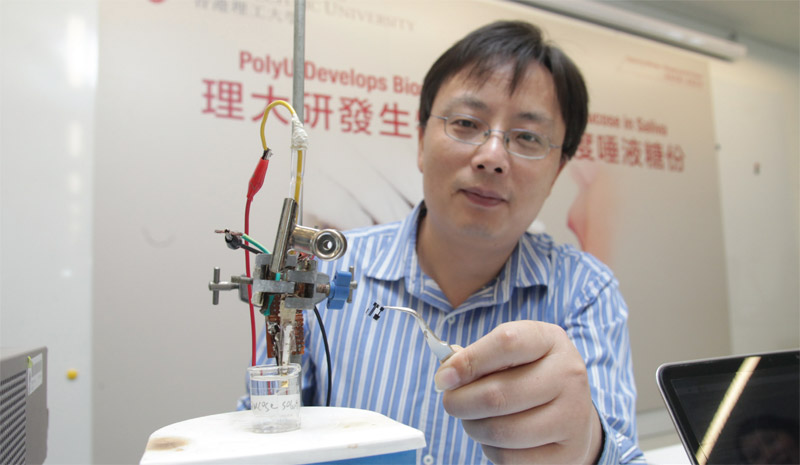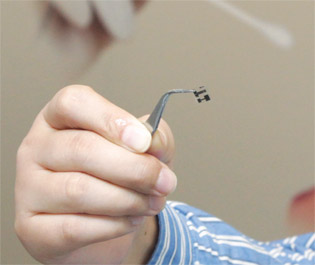
Dr Yan Feng demonstrates how to measure glucose in saliva with the ultra-sensitive biosensor.
Glucose level in saliva can now be measured more conveniently, safely and inexpensively with an ultra-sensitive transistor-based biosensor developed by PolyU.
Pricking a finger to monitor blood glucose level is an often necessary but painful routine in the everyday lives of diabetes patients. To overcome this problem, a research team led by Dr Yan Feng at the Department of Applied Physics has developed an ultra-sensitive transistor-based biosensor that can measure glucose concentration in saliva.
Glucose levels in salvia are usually too low to be detected ─ only 1/10 to 1/100 of that in blood sample. With this challenge in mind, the team fabricated the biosensor with a glucose oxidase enzyme (GOx) layer, making it sensitive only to glucose. It simply measures the glucose level by detecting the electric current in saliva. However, other biological elements in saliva such as dopamine, uric acid and ascorbic acid may interfere with the electric current and thus affect the glucose reading. To avoid such interference, bilayer films of Polyaniline/Nafion-graphene are placed between the top enzyme layer and gate electrode.
"The strong adhesion of the bilayer films enables the GOx layer to stabilise on the gate electrode, enhancing the measurement performance," Dr Yan explained. The biosensor can detect glucose level as low as 10-5 mmol/L, nearly a thousand times more sensitive than a conventional blood-glucose measuring device. Its accuracy has been proven with results corresponding to solutions with known glucose levels in rounds of repeated laboratory experiments. The research findings were published in Advanced Materials, a major academic journal in materials science.

The biosensor can be fabricated with flexible substrates to apply on curved and moving surfaces, including human skin and bandages.
Apart from being inexpensive to manufacture, the biosensor can be fabricated with flexible substrates to apply on curved and moving surfaces, including human skin, smart textiles and medical bandages. The potential for developing wearable electronics is thus huge; a wearable biosensor for measuring glucose level in sweat during exercise, for example, is now possible.
This new device has made the painful finger prick a thing of the past. The team is now improving and optimising it so it can serve as a sensing platform for various other biological elements, such as uric acid, cholesterol and dopamine. ♦
